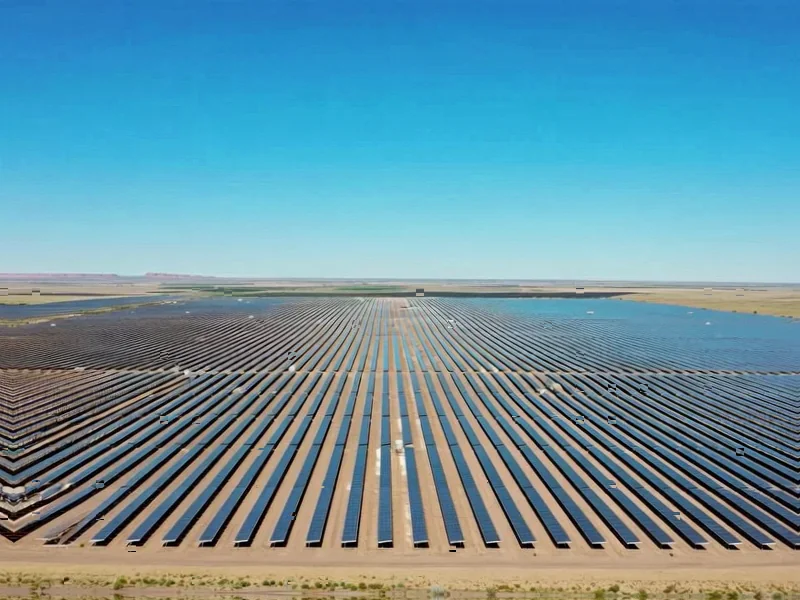According to DCD, Amazon has signed a 28MW power purchase agreement with Swedish renewables developer OX2 AB for energy from the Annopol wind park currently under development in Poland’s Lublin Voivodeship. The 40MW onshore wind farm is scheduled to go online in 2027, marking Amazon’s second PPA with OX2 following a 472MW agreement for two Finnish wind farms earlier this year. This Polish deal comes just one week after Amazon secured a separate 164MW solar PPA with R.Power SA in Poland’s Opole and West Pomeranian Voivodeships, bringing Amazon’s total renewable energy portfolio in Poland to approximately 333MW. The e-commerce and cloud giant, which was recently named Europe’s top corporate renewable energy buyer, continues pursuing its 2040 net-zero emissions target through strategic energy partnerships across key markets.
The Hyperscale Energy Imperative
What makes Amazon’s Polish investment particularly significant isn’t the 28MW capacity itself, but the strategic pattern it reveals. Hyperscale operators are no longer simply buying renewable energy credits or participating in green energy programs—they’re becoming active participants in energy infrastructure development. By committing to purchase power from projects still in development, companies like Amazon provide the financial certainty that enables construction of new renewable capacity that might otherwise struggle to secure funding. This transforms them from energy consumers into energy market makers, fundamentally altering the economics of renewable development across Europe.
Why Poland Matters Beyond the Megawatts
Amazon’s concentrated investments in Poland—now totaling over 330MW across multiple projects—signal a broader strategic shift in European cloud infrastructure geography. Poland represents one of Europe’s fastest-growing digital economies with significant manufacturing and logistics presence, making it an ideal location for edge computing and regional cloud infrastructure. More importantly, Poland’s energy grid remains heavily dependent on coal, creating both a challenge and opportunity for large energy consumers. By investing in local renewable generation, Amazon not only secures clean power for its operations but also gains influence over energy policy and pricing in a market where electricity costs have been volatile. This creates a competitive moat that extends beyond traditional cloud service differentiators.
The Developer Relationship Advantage
Amazon’s repeated partnerships with OX2—following the Finnish agreement earlier this year and now the Polish project—reveal another strategic dimension: the value of established developer relationships. Rather than treating each PPA as a discrete transaction, Amazon is building portfolio partnerships that give it preferential access to new projects and development pipelines. For OX2, having a reliable anchor tenant like Amazon reduces development risk and accelerates project timelines. This symbiotic relationship creates a competitive advantage that’s difficult for smaller cloud providers to replicate, potentially consolidating the hyperscale market’s dominance as renewable energy becomes increasingly central to data center operations.
Accelerating Europe’s Energy Transition
The timing of these investments coincides with Europe’s accelerated push toward energy independence following geopolitical disruptions to traditional energy supplies. Corporate PPAs have become a critical driver of renewable capacity growth across the continent, with technology companies leading the charge. Amazon’s Polish investments demonstrate how corporate energy strategy now intersects with national energy security concerns. By committing to local renewable generation, hyperscalers provide the demand certainty that enables countries like Poland to transition their energy mix more rapidly while simultaneously securing their own operational resilience against potential energy market disruptions.
The Coming Capacity Crunch
Looking forward, the strategic value of these energy partnerships will only increase as data center energy demands continue their exponential growth. The AI compute revolution is creating unprecedented power requirements that existing grids cannot support without significant new generation capacity. Companies that have established renewable energy pipelines and developer relationships will have a distinct advantage in scaling their AI infrastructure. We’re likely to see increasing competition for renewable energy projects near key data center hubs, potentially leading to strategic acquisitions of developers or energy assets as hyperscalers seek to secure their power futures in an increasingly constrained energy landscape.




